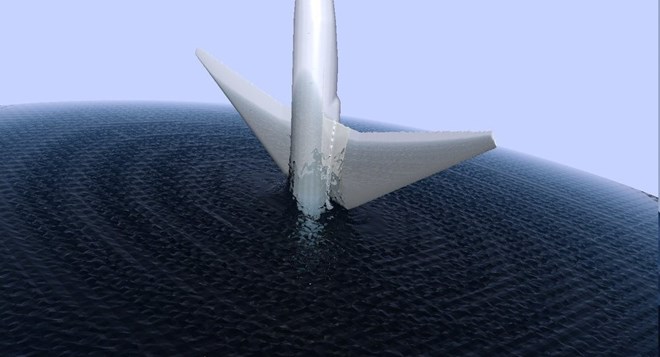Find a solution to the mystery of why MH370 left no fragments
A team of researchers from Texas A&M University, Massachusetts Institute of Technology and Qatar Institute of Energy & Environment Research, under the leadership of a mathematics professor, has made many simulation calculations, using Computing and hydrodynamic math applications about the mysterious disappearance of Malaysia Airlines aircraft bearing the MH370 number.
Why does MH370 leave no fragments?
They believe that the plane has perpendicular to the sea surface. This type of impact makes the aircraft intact and does not create debris or oil stains like in other normal accidents.
"The final moments of MH370 will remain mysterious until someday, when black boxes are found," said Dr. Goong Chen, a mathematician from the research group. "But analytical calculations show that MH370 is likely to have plunged into the sea."

Simulation image.(Source: sputniknews.com)
The group publicly published the results of their research, which was done after many arithmetic simulations, created on the RAAD supercomputer , located at Texas A&M. The results also appeared in the April 2015 issue of the scientific journal Notices of the American Mathematical Society.
According to scientists, in any search and rescue operation related to plane crash, debris and oil spills are always very important. So Chen was puzzled, not knowing why there was no fragment in MH370?
The computer emulators helped them see that the plane was likely to plunge vertically , or with an angle almost almost perpendicular to the water.
The group used five different scenarios, including the plane sliding on the water, as in the case of Captain Chesley B. 'Sully ' Sullenberger used to land a US Airways aircraft on the Hudson River.
The hydrodynamic simulation found that if the plane plunged directly into the water, the large bending moment would not appear. The bending moment occurs when the external force exerts a strong impact on a structure (like an airplane) and a large bending moment causes the body to break, creating debris. When the plane dives perpendicular to the water surface, it only receives small bending moments so it is more difficult to break the body.
Based on references from other aviation experts, Chen said that in such a crash, the wings of an airplane would immediately leave the body and, along with other large debris, would sink right down to the bottom. Sea, leaving little trace on the water.
The Boeing 777, bearing the number MH370, along with 239 passengers and crew members, disappeared while traveling from Kuala Lumpur (Malaysia) to Beijing (China). After about an hour of travel, the plane disappeared from the radar screen, apparently falling into the Indian Ocean. Until now, no trace of the plane has been found./.
- Two fragments are confirmed 'almost certainly' by MH370
- The cockpit of MH370 may have been ripped apart
- At the end of MH370, jump out of the sky and head straight into the sea!
- Newly discovered fragments of missing aircraft MH370
- Australia found the missing area of MH370?
- The real reason did not find MH370 for more than 3 years?
- Decipher the mysterious plane missing MH370?
- The culprit makes it difficult to find aircraft MH370
- New detection can help pinpoint the exact location of the MH370
- Detecting suspected aircraft fragments of MH370 in Maldives
- Found 53 'meteorite fragments'
- Hot: Detect a mysterious group of passengers that can attack MH370
 'Fine laughs' - Scary and painful torture in ancient times
'Fine laughs' - Scary and painful torture in ancient times The sequence of numbers 142857 of the Egyptian pyramids is known as the strangest number in the world - Why?
The sequence of numbers 142857 of the Egyptian pyramids is known as the strangest number in the world - Why? History of the iron
History of the iron What is alum?
What is alum?